What to do and see in Las Palmas de Gran Canaria: Complete Guide to Enjoy the City
Las Palmas de Gran Canaria offers endless activities to enjoy. From walking through the old town of Vegueta to exploring the modernist neighborhood of Triana, the city dazzles with its history and architecture. In addition, you can visit museums, attend cultural events or relax on the beaches. Parks, viewpoints and nature trails complete a unique experience in this beautiful destination.
Las Palmas de Gran Canaria is a vibrant city that combines tradition and modernity. With its golden sandy beaches, a pleasant year-round climate and a cultural heritage enriched by the influence of diverse cultures, the city offers a unique experience. From its historical monuments, such as Vegueta, to its modern infrastructure, the city invites to be explored on foot,
enjoying its architecture, museums and plazas. In addition, Las Palmas is a paradise for water sports and nature lovers, with options for hiking and outdoor adventures. With its rich gastronomy and nightlife, Las Palmas has established itself as one of the most attractive destinations for tourists from all over the world.
- 1. Las Palmas de Gran Canaria's must-sees
- 2. Exploring the Vegueta neighborhood
- 3. The majestic Santa Ana Cathedral
- 4. Triana: The Modernist Neighborhood
- 5. Paradise beaches and local nature
- 6. Flavors of Las Palmas: Where to eat
- 7. Culture and renowned events
- 8. Getaways and nearby natural sites
- 9. Enjoying Sunsets and Walks
Neighborhood of Vegueta

Vegueta
Place that saw the birth of Las Palmas de Gran Canaria. Known for being the historic district of Las Palmas, it reflects a colonial architecture with its beautiful cobblestone streets. The neighborhood par excellence of most museums.
Leisure activities:
- On Sundays there is a Crafts and Culture Market in Vegueta, from 08:00 to 14:00 hours.
- During the year it is an area of celebration of music festivals, dance and cultural activities.
Triana Neighborhood
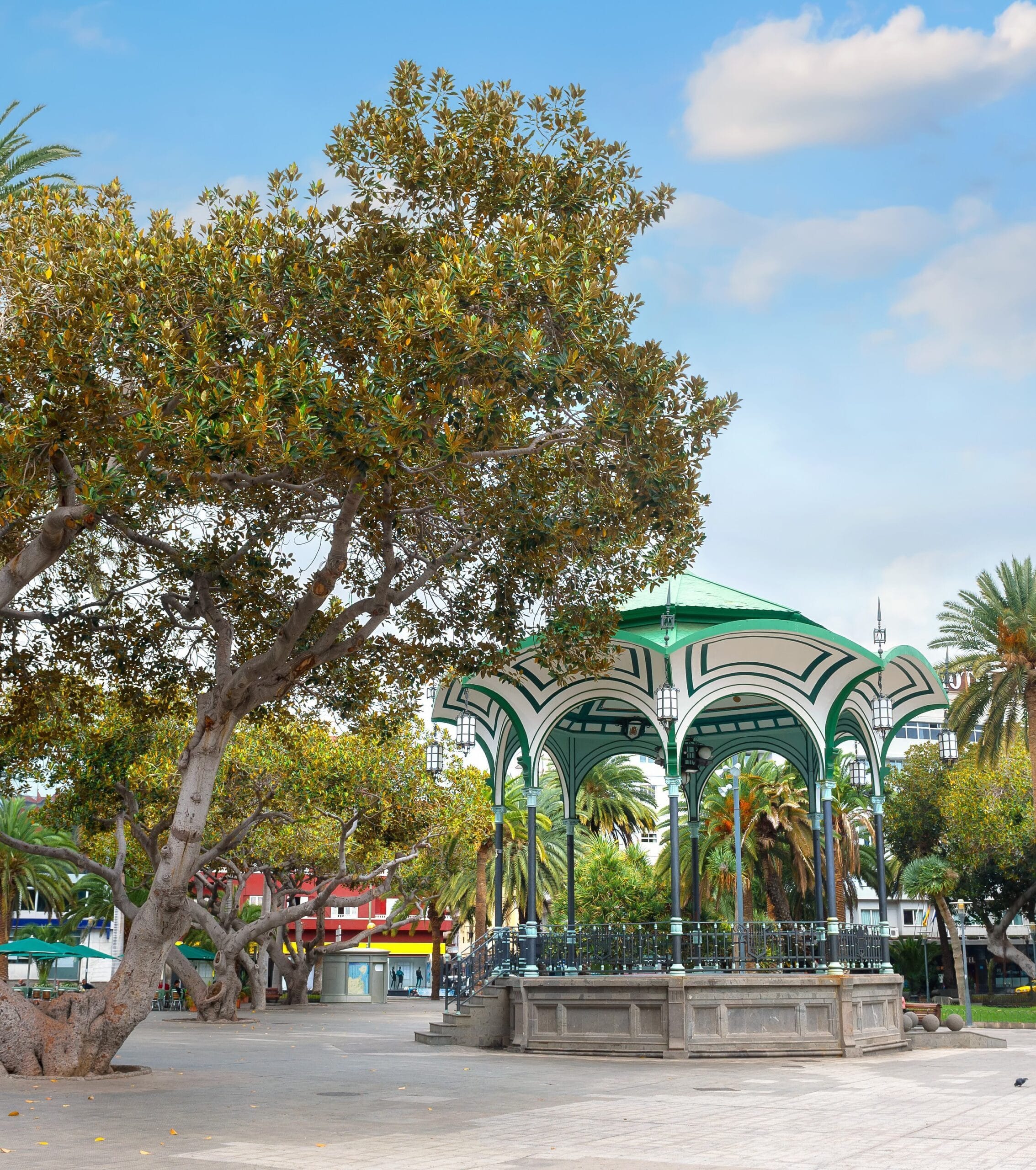
History and architecture of Triana
Triana was born from the expansion of the historic district of Vegueta, with a combination of cultural and commercial elements. Very close to the neighborhood of Vegueta.
Sites of interest:
Leisure activities:
- Shopping in the Main Street of Triana.
- Wide gastronomic offer with many restaurants, cafeterias.
- La Azotea de Benito: A rooftop where you can have a drink with good views.
- Triana Zone Events
Mesa y Lopez commercial zone
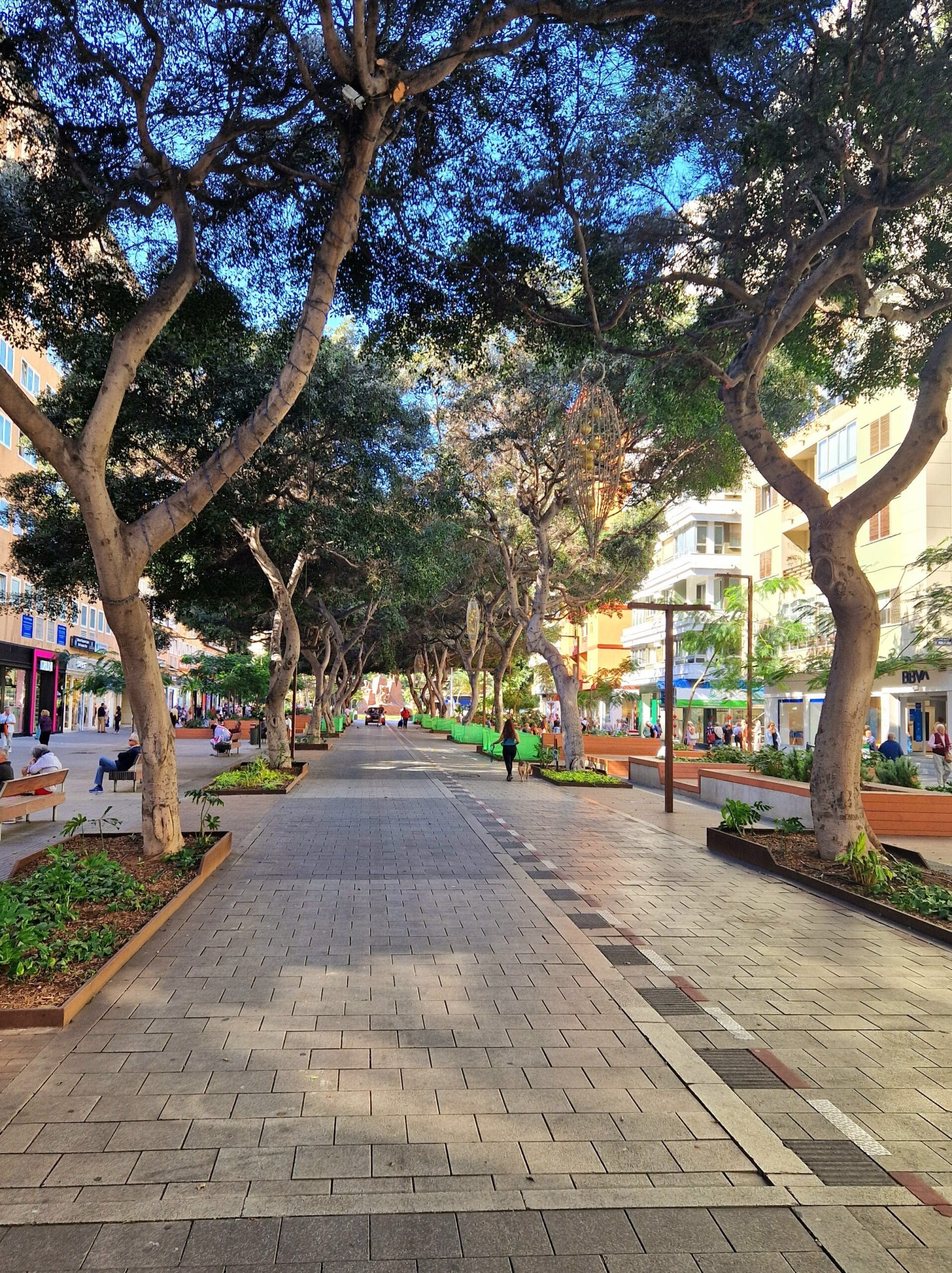
Mesa y Lopez
One of the main commercial areas of the city. Presence of numerous stores, boutiques, department stores.Very close to Santa Catalina park and Las Canteras beach.
Leisure activities:
- TAJ Rooftop & Lounge: Rooftop where you can enjoy the views of the beach of Las Alcaravaneras.
- Las Palmas Marina : For nautical lovers.
- Roman Park:The more athletic have the main park where locals train.
Santa Catalina Park
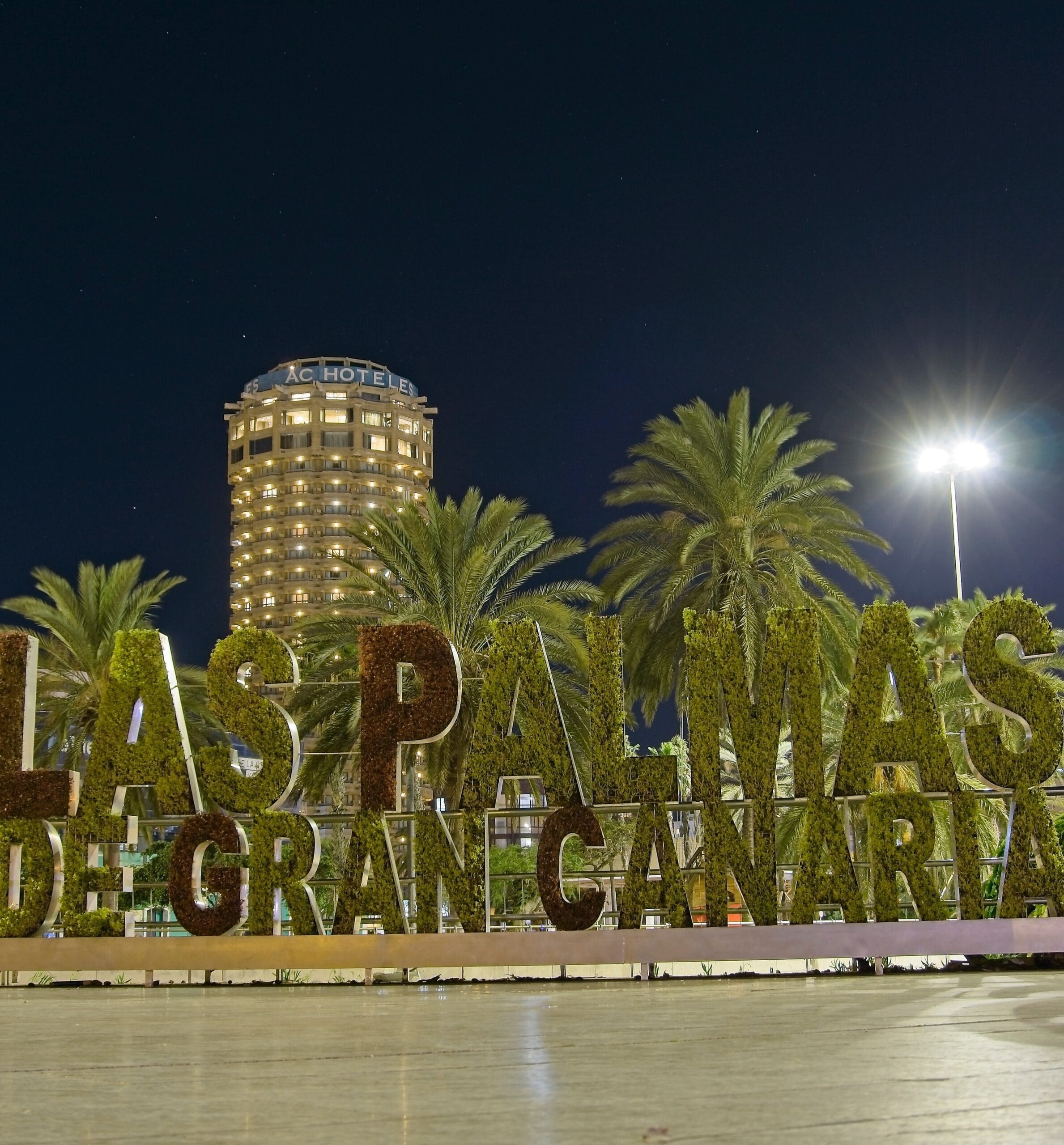
Santa Catalina Park
One of the main meeting points for the local population. Throughout the year, Santa Catalina Park hosts various cultural events, fairs, concerts and festivals.
Sites of interest:
Recommendation:
- Santa Catalina interchange: Place where a large number of buses leave for different parts of the island.
Las Canteras Beach

Las Canteras Beach
Urban beach of more than 3 kilometers long, has a natural barrier known as "La Barra", which protects from the tides. Ideal place to swim, snorkel and practice sports such as surfing.
Areas of La Playa:
La Cícer:
Sports area, especially surfing and body boarding.
It runs approximately from the Alfredo Kraus Auditorium to the rock called “Peña La Vieja”. “Peña La Vieja”.
Some points of interest:
Peña La Vieja:
The most famous rock of Las Canteras beach.
In this area you will find the ice cream parlor “ Peña La Vieja “.
Founded in 1936, this legendary ice cream parlor refreshes the locals all year round.
Playa Chica and Marrero wall:
The most familiar area
Kayak Rental
Playa Grande:
Then, after passing Playa Chica
Tourist area with a concentration of hotels and apartments.
- Thalassotherapy Las Canteras, relaxing option after a day at the beach
- Port Market nearby, with gastronomic options and live music.
La Puntilla:
After passing Playa Grande we will come across the fishermen’s area and their boats.
The Puntilla Square is an ideal place to enjoy a magical sunset.
Bandama Caldera

Bandama Caldera
Protected natural area. It offers spectacular views of a volcanic crater. It is a good place to understand the geological history of Gran Canaria. The area is home to a great variety of endemic plants and animals and for nature lovers there are several hiking trails.
Volcanic crater of approximately 1,000 meters in diameter and 200 meters deep. This natural monument offers a unique landscape with panoramic views from its viewpoint, where you can see the crater walls covered with endemic vegetation and the bottom of the caldera ancient farming terraces. It is a popular destination for hiking and bird watching, providing an unforgettable experience of the volcanic nature of Gran Canaria.
Nearby:
Viera y Clavijo Botanical Garden
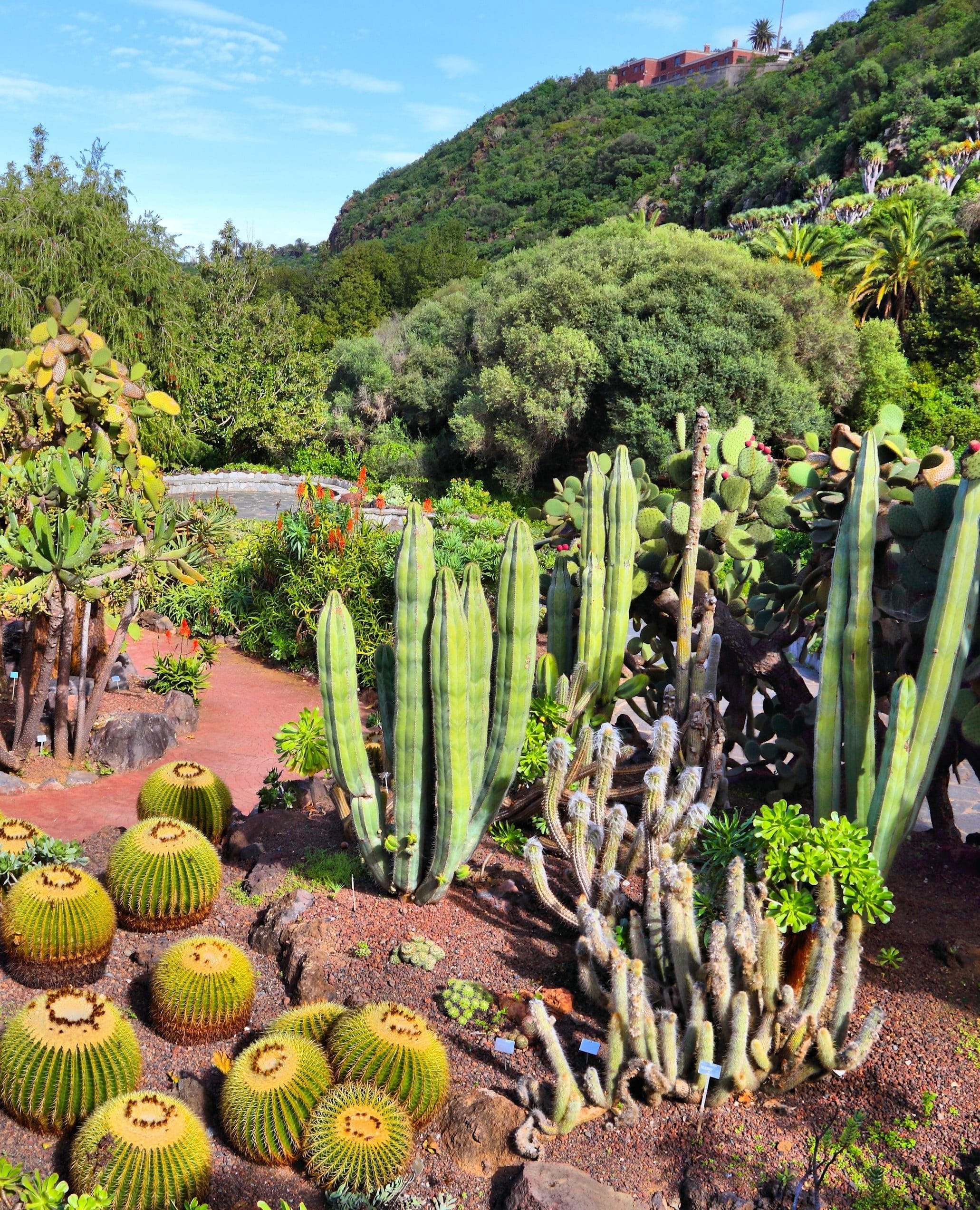
Viera y Clavijo Botanical Garden
Beautiful environment to spend a day with the family. We are talking about the largest botanical garden in Spain, specialized in the flora of Macaronesia, offering a diverse collection of endemic plants. It is a window to the botanical richness of the Canary Islands.
Located in the Guiniguada ravine, in Gran Canaria, this garden was founded in 1952 by the Swedish botanist Eric Sventenius. It occupies an area of 27 hectares and houses a large collection of endemic flora of the Canary Islands, as well as plants from other regions of the world.
Among its attractions are the Cactus and Succulents Garden, the Macaronesian Garden, and the Canarian Pine Forest. This garden is not only an ideal place for botany lovers, but also for those who wish to enjoy a unique natural environment and learn about the plant diversity of the Canary Islands archipelago.
Entrance FREE
Schedule
Monday to Friday
– 7:30 A 19:00 (summer schedule, from April to September).
– 7:30 A 18:00 (winter schedule, from October to March).
Saturdays, Sundays and holidays: 10:00 A 18:00 (all year round).
1. Las Palmas de Gran Canaria's must-sees
Las Palmas de Gran Canaria offers a variety of experiences that blend history, culture and opportunities for relaxation. With both historical and recreational landmarks, this city is a must-see for any visitor.

History and culture
The history of Las Palmas is rich and varied, with many roots that intertwine throughout its development. The streets of the city tell stories that date back centuries. One of the most significant areas is Vegueta, where you can observe colonial architecture, including buildings that have withstood the test of time.
Vegueta
This neighborhood, the heart of the city’s history, is home to the Plaza de San Antonio Abad, one of the most emblematic squares in the capital.
Columbus House
A place not to be missed is the Casa de Colón, a museum that highlights the relevance of Christopher Columbus in the history of the Canary Islands and its links with America. This house is not only perceived for its architectural value, but also for its ability to connect visitors to the migration and influence of the Canary Islands in America.

Relaxation and leisure
The city also stands out for its relaxation and leisure options. Its beaches are a refuge for those looking to rest and enjoy the sun. Las Canteras Beach offers a perfect space to enjoy a relaxed atmosphere, where the golden sand and the ocean become the protagonists of the day.
Beach activities
- Water sports such as surfing and paddle surfing.
- Restaurants offering delicious seafood and fresh fish dishes.
- Walks along the promenade, ideal to enjoy a walk at sunset.
Cultural events
Las Palmas does not skimp on cultural activities. Throughout the year, the city hosts various festivals and events that celebrate its rich culture. From the famous Carnival, full of color and music, to art exhibitions and theater, there is something for everyone.
2. Exploring the Vegueta neighborhood
Vegueta is the old town of Las Palmas de Gran Canaria, a place where history comes alive. Its cobblestone streets and colonial architecture invite you to discover its secrets and immerse yourself in the city's rich cultural heritage.

San Antonio Abad Square
The Plaza de San Antonio Abad is the heart of Vegueta. This emblematic space is not only notable for its history, but is also a key reference point for visitors.
In the surroundings, you can appreciate historical buildings that add a special touch to the square. It is surprising to observe the colonial facades adorned with wooden balconies that evoke past times, which makes it a mandatory stop for photography lovers.
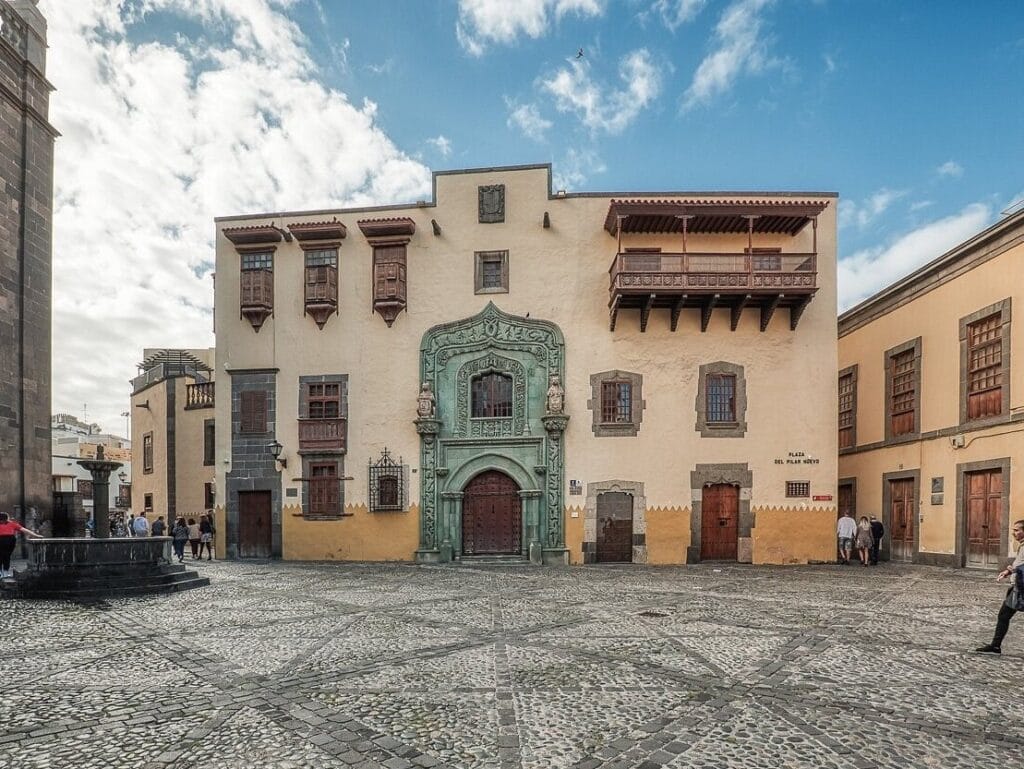
Columbus House
The Casa de Colón, located near the square, is a museum that pays homage to Christopher Columbus. This building, which once served as the navigator’s residence, features fascinating exhibits about his voyages and the migration between the Canary Islands and America.
Visitors can explore several rooms that include historical and artistic objects related to the expedition. The architecture of the Columbus House stands out for its colonial style, with beautiful courtyards and gardens that invite reflection.

Canary Island Museum
The Museo Canario is another highlight of Vegueta. This museum houses an extensive collection of artifacts that showcase the history and culture of the Canary Islands before the arrival of Europeans. Archaeological pieces, indigenous art objects and exhibits on local flora and fauna provide a comprehensive view of the indigenous heritage.
The tour of the museum is an educational experience that allows visitors to delve deeper into the cultural aspects of the islands. In addition, the building itself, with its traditional design, adds historical value to the ensemble that makes up Vegueta.
3. The majestic Santa Ana Cathedral
The Cathedral of Santa Ana, located in the heart of Vegueta, is one of the most emblematic monuments of Las Palmas de Gran Canaria. This majestic building, witness of the historical evolution of the city, stands out for its impressive architecture and spiritual importance.
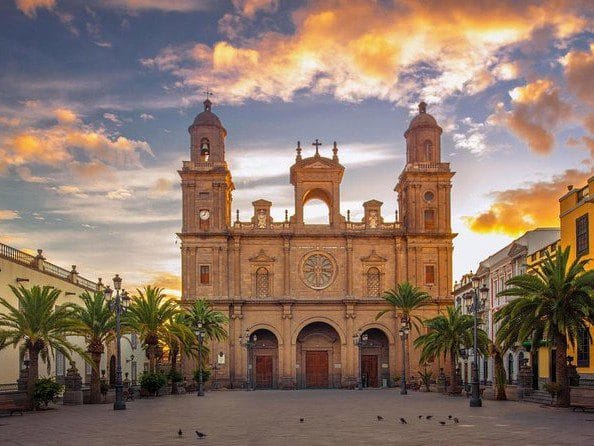
Mix of architectural styles
The Cathedral of Santa Ana is a significant example of the rich architectural heritage of the Canary Islands. Its construction began in the 16th century and lasted for several centuries, which has resulted in a fusion of architectural styles that make it unique. The main styles present are Gothic, Renaissance and Neoclassical.
Visitors can observe this eclecticism in detail, especially on its main façade, which features Gothic elements such as the arches, as well as Renaissance details in its sculptures and friezes. The south tower, which rises to 60 meters, is especially remarkable: its red brick structure contrasts with the light stone walls of the rest of the building.
The interior of the cathedral is equally impressive. Upon entering, one appreciates the grandeur of the central nave, with high ceilings and beautiful vaults. The various chapels on the sides house numerous altars and works of art that reflect the religious history of the island.

Photography with the dogs of Santa Ana
One of the most characteristic elements of the Cathedral of Santa Ana are the statues of dogs that are located in the square of its frontispiece. These sculptures, which represent dogs of the “perro de presa canario” breed, have become a symbol of the city. Tourists and locals often take pictures next to these statues, which are guarded by two magnificent bronze dogs.
The tradition of taking pictures with the dogs of Santa Ana is a popular activity among visitors of all ages. The plaza surrounding the cathedral offers a picturesque setting, ideal for capturing memorable images of the monument and its canine symbolism.
Sunset in the square is especially magical, as the golden sunlight highlights the features of the cathedral and statues, creating an impressive visual contrast. This place is not only a cultural and religious landmark, but also a space where memories are immortalized through photography.
4. Triana: The Modernist Neighborhood
Triana is a neighborhood of great vitality and color that stands out for its modernist architecture and interesting history. With lively streets and a rich cultural offer, this area is one of the most attractive places in Las Palmas de Gran Canaria.Main Street of Triana

Main Street of Triana
The Calle Mayor de Triana is one of the main commercial and cultural arteries of the city. This pedestrian promenade is full of life and energy, where you can find numerous stores, boutiques and cafes. The buildings flanking the street are a reflection of the Canarian modernist style, with ornate facades and colorful tiles that capture everyone’s attention.
Among the stores, some are traditional and others more innovative. Here, visitors can enjoy a pleasant stroll, mixing shopping with moments of relaxation. Savoring a guirlache ice cream is an experience recommended by the locals. The vibrant atmosphere of this street is ideal for observing the daily life of its inhabitants and enjoying its unique charm.
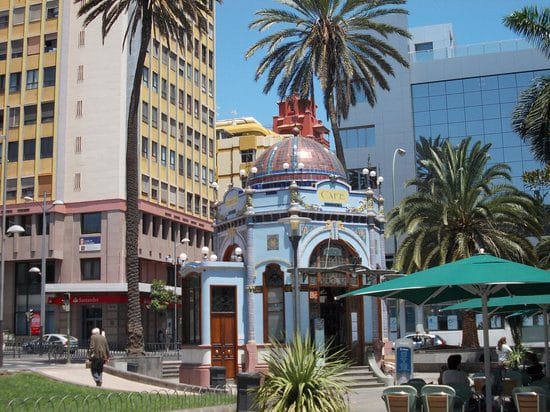
San Telmo Park
San Telmo Park stands as a green lung in the heart of Triana. This space is famous for its historic kiosk, which has been converted into an outdoor café. It is a favorite spot for residents, who come to enjoy a coffee or snack in a relaxed setting. The park is filled with sculptures, manicured gardens and seating areas that invite you to spend some quiet time.
Spending time in San Telmo Park is a perfect way to disconnect from the hustle and bustle of the city. Families, young people and tourists meet here to socialize or simply enjoy some time outdoors. The beauty of the park makes it an ideal place to take a break and soak up the sun while contemplating the dynamic life of the neighborhood.
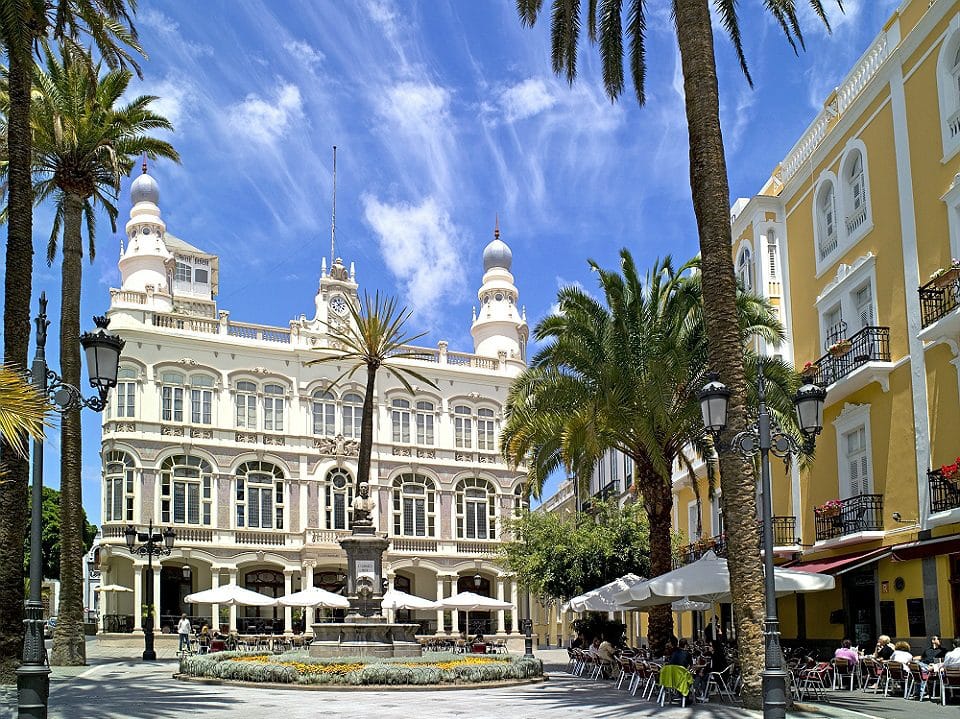
Literary Cabinet
The Gabinete Literario is an emblematic cultural and gastronomic space located in Triana. This place has witnessed various literary and artistic activities throughout its history. It has also been the setting for the filming of popular movies, which adds to its appeal. The mix of art, culture and Canarian cuisine make it a must-see.
Inside, numerous activities are organized such as exhibitions, conferences and book presentations, which encourage interaction between artists and the community. Visitors can enjoy gastronomic offerings ranging from traditional tapas to a selection of local wines, which complements the cultural experience.
The combination of literary atmosphere and gastronomy makes the Gabinete an ideal meeting point for culture lovers. Regular events guarantee a dynamic and attractive program throughout the year.
5. Paradise beaches and local nature
Las Palmas de Gran Canaria has numerous dream beaches and natural spaces that offer a variety of outdoor activities. These areas are perfect for relaxing, practicing water sports or simply enjoying the splendor of the natural environment.
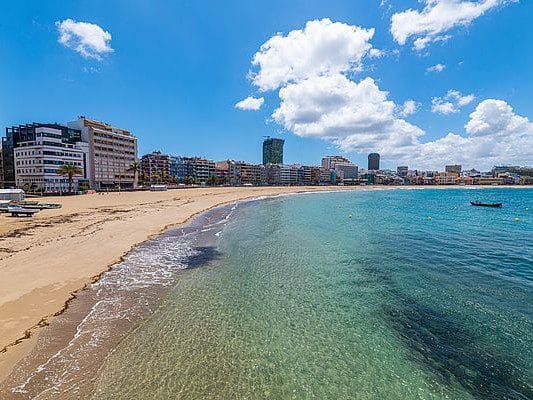
Las Canteras Beach
Las Canteras Beach is undoubtedly the most emblematic of the city. Its long stretch of golden sand, stretching for a kilometer, attracts both locals and tourists. The crystal-clear waters are ideal for swimming, and its location is protected by a natural reef, ensuring optimal conditions for swimming all year round.
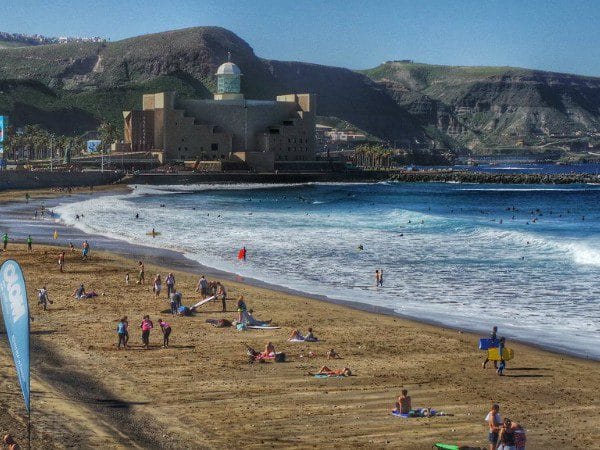
Aquatic activities
Las Canteras Beach is a true paradise for water sports lovers. Apart from surfing, which has its own place on the beach, there is a rich offer of activities available, such as:
- Paddle surf
- Scuba diving, where you can explore the local marine life

Maspalomas Dunes Natural Park
Just a short drive from Las Palmas, the Natural Park of the Maspalomas Dunes is another of the great attractions of Gran Canaria. This protected area stands out for its impressive landscapes of sand dunes, lakes and palm groves.
It is also a unique opportunity to appreciate the beauty of the sunset, especially when the sun sets behind the dunes, creating an impressive visual spectacle.
6. Flavors of Las Palmas: Where to eat
The gastronomy of Las Palmas de Gran Canaria is a reflection of its history and culture. Made with fresh, local ingredients, Canarian food offers a unique sensory experience. Two of the most outstanding places to enjoy local flavors are the Mercado del Puerto and the Mercado de Vegueta.
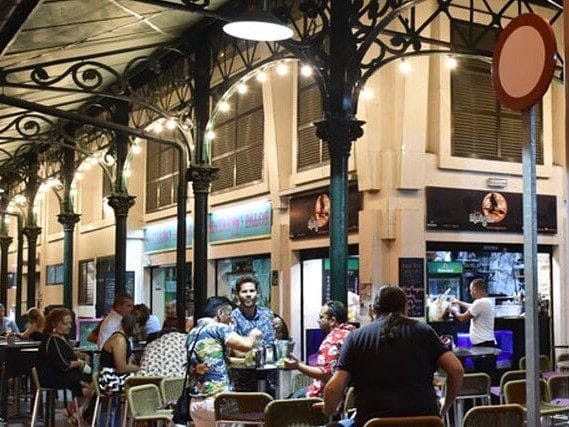
Port Market
The Mercado del Puerto is an emblematic place for food lovers. Located in a former port facility, this market has been revitalized and has become a meeting point for locals and visitors alike. Its vibrant atmosphere is full of color and life, with numerous stalls offering fresh produce and a variety of typical Canarian dishes.
- Local gastronomy: In the market you can taste traditional tapas, fresh seafood and preparations with seafood products, such as the famous mojo and wrinkled potatoes.
- Charming restaurants: Along its corridors, you can find different restaurants and bars serving Canarian food with a contemporary twist. Local chefs use local ingredients to offer unique menus.
- Festive atmosphere: During the weekends, the Mercado del Puerto comes alive with live music and culinary events, creating an ideal space to enjoy Canarian gastronomy in a festive environment.
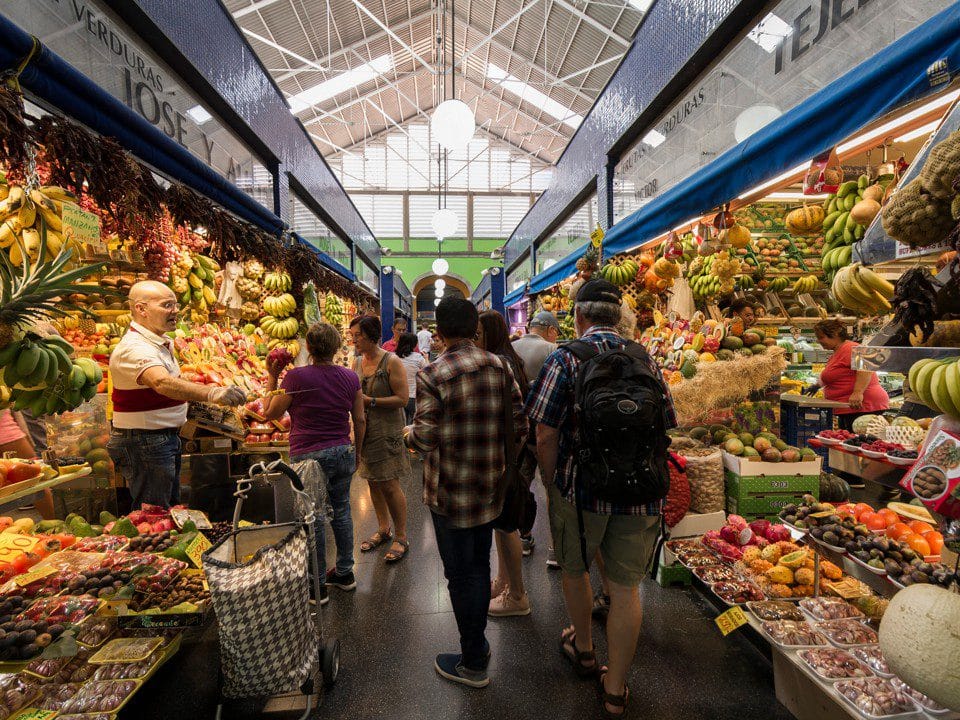
Vegueta Market
The Vegueta Market is another culinary destination not to be missed. Located in the heart of the historic district, this market stands out for its tradition and authenticity. Visitors can enjoy a relaxed environment while exploring the various fruit, vegetable and gourmet stalls.
- Fresh products: Here you can find seasonal local products, ideal for those who are looking to savor the essence of the Canary Islands in every bite.
- Culinary tastings: Many of the vendors offer small tastings, allowing visitors to try before they buy. Canned fish and artisanal cheeses are especially recommended.
- Local interaction: This market is a meeting point for residents, providing an authentic experience and allowing visitors to immerse themselves in Canarian culture.
7. Culture and renowned events
Las Palmas de Gran Canaria is a cultural hotbed, where events of great relevance take place, attracting both locals and visitors. The city has multiple spaces dedicated to culture and hosts festivals that celebrate music, art and local traditions.
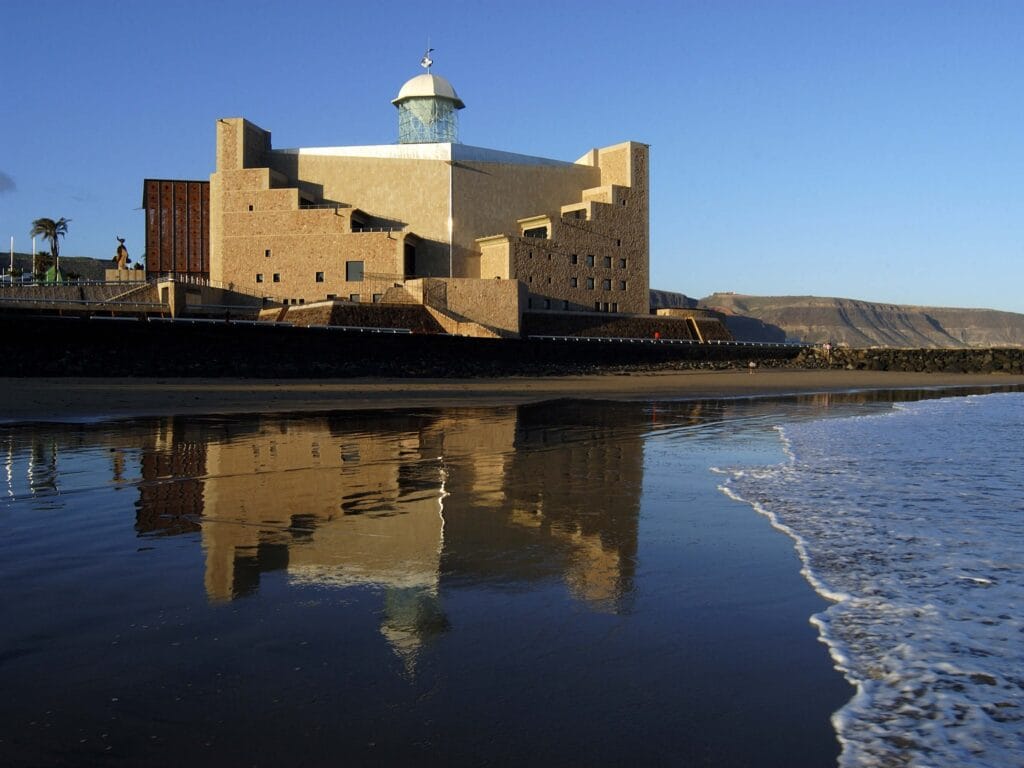
Alfredo Kraus Auditorium
Inaugurated in 1997, the Alfredo Kraus Auditorium stands as an architectural icon of the city. This modern venue, located by the sea, stands out not only for its impressive design, but also for its international cultural program. Visitors can enjoy classical music concerts, opera and contemporary musical events.
The auditorium is also a space for local artistic promotion, offering a stage for musicians and theater companies from the Canary Islands. The acoustics of this venue have been recognized as one of the best, making it a privileged destination for music lovers.
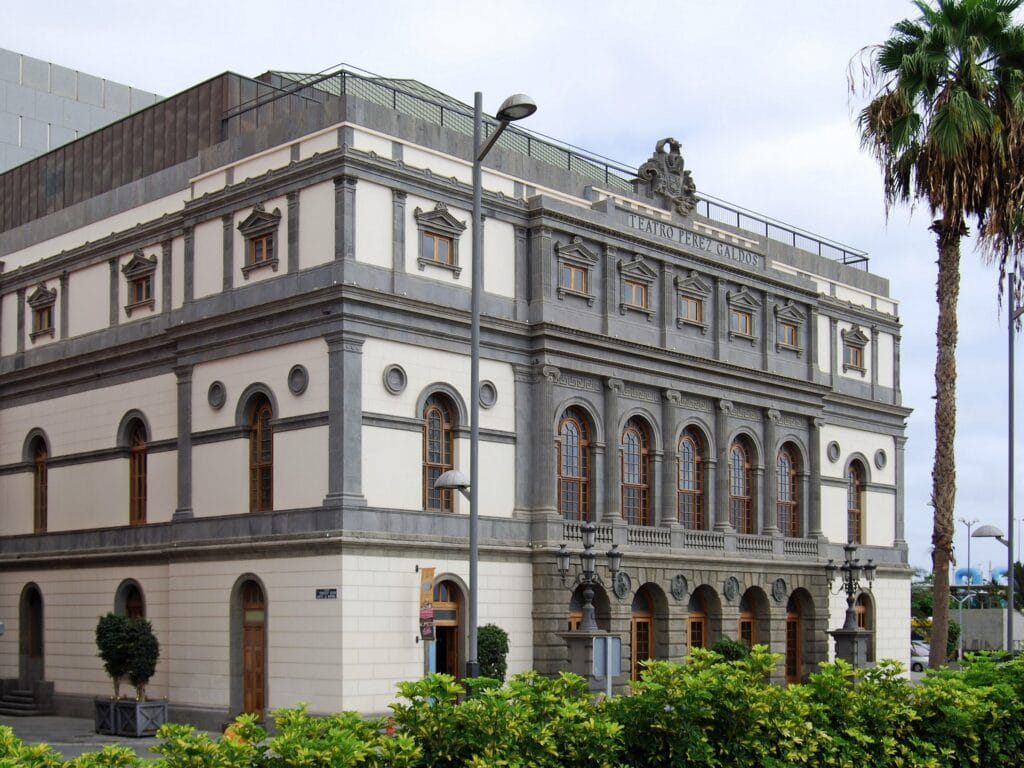
Pérez Galdós Theater
The Pérez Galdós Theater, named after the famous writer from the Canary Islands, is another cultural meeting point in the city. This emblematic building hosts a variety of shows, from plays and dance to concerts and gala events. Its interior decoration and historic ambience make each visit a unique experience.
Always committed to culture, the theater organizes activities to promote art among young people and has a diverse program that includes both local productions and those from outside the islands. The quality of the presentations is a hallmark of this great space.
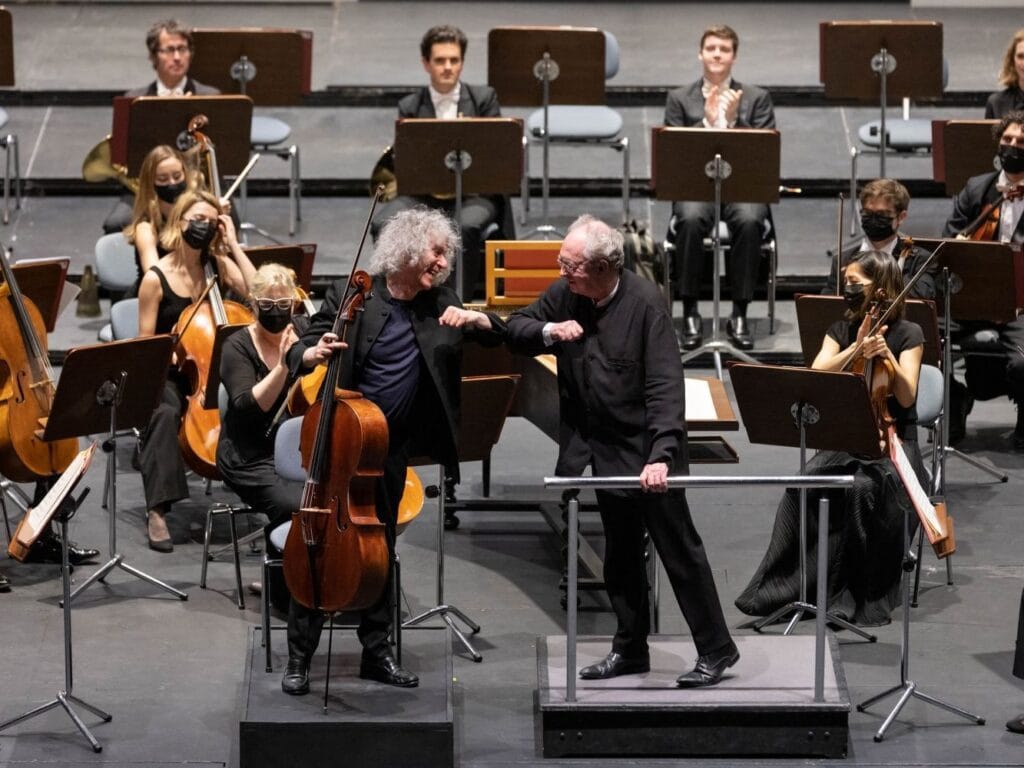
Canary Islands Music Festival
This annual festival is one of the most important events in the Canarian musical calendar. For several weeks, Las Palmas becomes a stage where works by world-renowned composers and musicians are presented. The variety of styles ranges from classical music to more contemporary proposals, making it an inclusive and attractive event for all audiences.
The concerts are held in different venues throughout the city, providing an opportunity for attendees to discover new places while enjoying music. This festival is a perfect example of the city’s commitment to promoting musical culture.
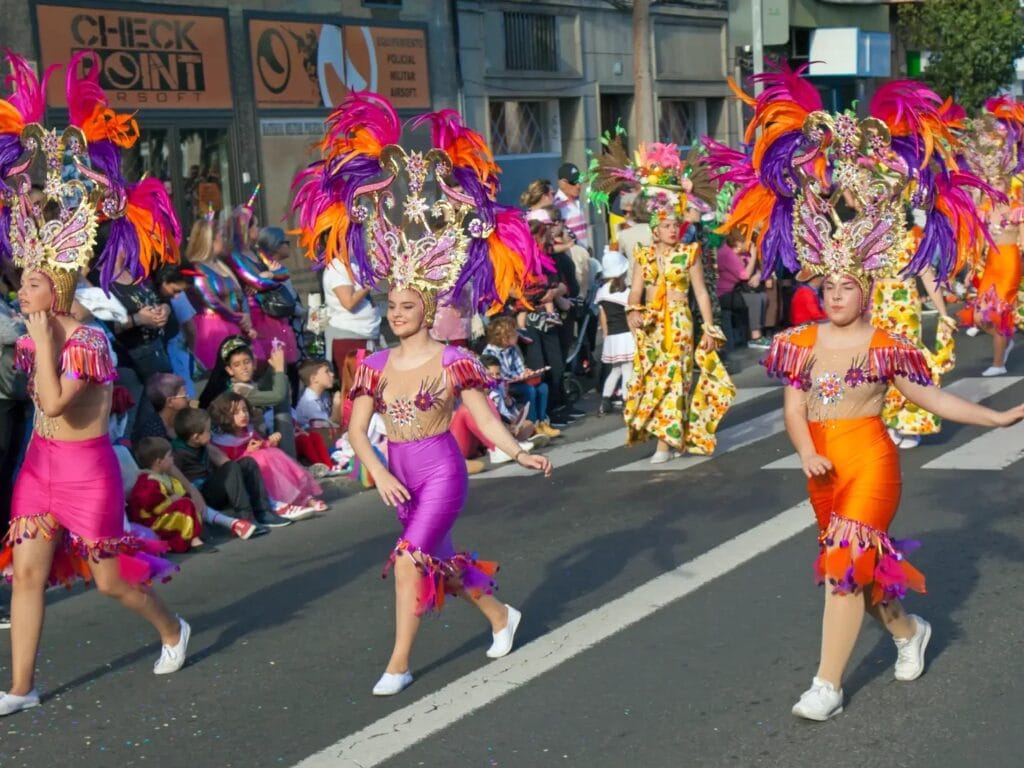
Carnival and local festivities
The Las Palmas carnival is known for being one of the most vibrant and colorful in Spain. With spectacular parades combining music, dance and visual spectacles, this annual event attracts thousands of visitors. During the weeks of celebration, the streets come alive with activities for all ages, including costume contests and live performances.
Local festivities are not limited to the carnival. Throughout the year, the city hosts fairs, art exhibitions and events that highlight Canarian traditions. Some of these events highlight local gastronomy, art and music, making Las Palmas an energetic cultural epicenter.
8. Getaways and nearby natural sites
Las Palmas de Gran Canaria offers several getaways to enjoy nature and discover breathtaking landscapes. From mountains to coastline, these nearby natural places are perfect for an adventure outside the city.
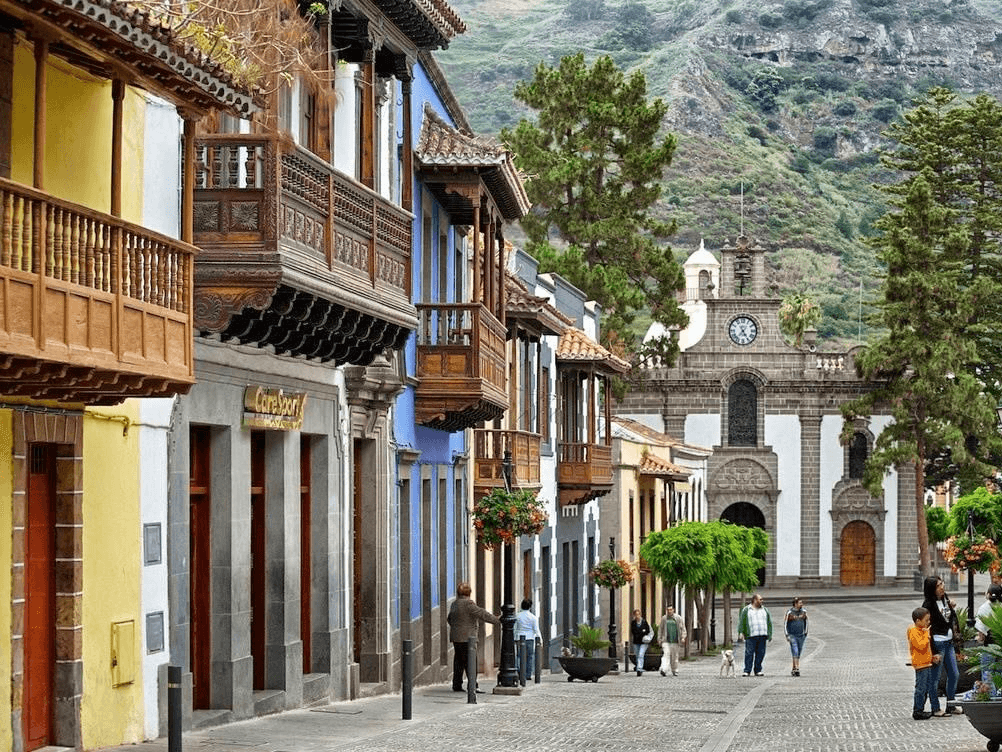
North of Gran Canaria
The northern part of Gran Canaria is known for its lush vegetation and mountainous landscapes. It is the ideal place for those looking for a cooler and greener natural environment. Among the most notable stops are:
Teror
This picturesque village is famous for its well-known Basilica of Nuestra Señora del Pino. Its cobblestone streets and typical Canarian architecture invite you to stroll and taste local products in its market.
Agaete
Located on the northwest coast, Agaete is famous for its cliffs and stunning ocean views. Here you can explore the Tamadaba Natural Park and enjoy its nature trails and the beauty of the volcanic landscape.
Guide
This municipality is known for its gastronomy, especially cheese. The area offers hiking trails with endemic flora and unforgettable landscapes.

Isleta and surroundings
La Isleta, located northeast of the city, is another place worth exploring. This area is known for its connection with nature and its amazing ocean views. The following attractions stand out:
La Isleta Natural Park
A protected area that encompasses several natural formations. Here you can hike and observe several species of migratory birds. The hiking trails offer panoramic views of the sea and the city.
Las Canteras
In addition to being a splendid beach, the Las Canteras area is also ideal for short walks along its edge.
Alcaravaneras Beach
Less crowded than Las Canteras, this beach is a quiet refuge for sand lovers. It offers ideal spaces to enjoy a moment of relaxation or practice water sports.
9. Enjoying Sunsets and Walks
Sunsets in Las Palmas de Gran Canaria are a spectacle not to be missed. With breathtaking landscapes and a mild climate, sunset walks become a magical experience. The city offers ample areas to enjoy these unique moments.

Las Canteras Promenade
The promenade of Las Palmas is one of the most emblematic places to enjoy the sea breeze and watch the sunset. This promenade extends along Las Canteras Beach, where the golden sand blends with the crystal clear waters of the ocean. It is an ideal space for both leisurely walks and recreational activities.
- Modern design that invites you to walk, run or ride a bike.
- Restaurants and bars along the promenade, perfect for a refreshing stop while watching the horizon.
- Rest areas with benches and green areas to enjoy the scenery in a relaxed atmosphere.
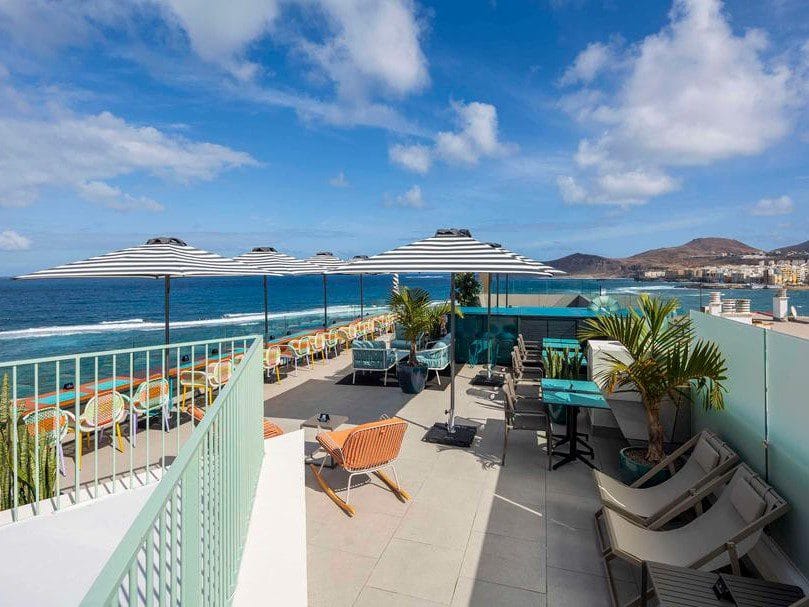
Best Sunsets at Las Canteras Beach
Las Canteras Beach is known for being a privileged place to enjoy breathtaking sunsets. There are certain specific points along the beach that are ideal to observe when the sun begins to set.
- El Confital and Las Coloradas: This location offers unobstructed views, perfect for photography.
- Rooftop Hotel Aloe Canteras: In front of this building, you can capture impressive reflections in the water, while the sun casts its last rays.
- The area of Playa de las Alcaravaneras: A little more secluded, this place offers a quieter and less crowded environment to enjoy the natural spectacle.
"When a canari@ says Machango: Person who does foolish things or behaves in a childish way".
Dichos Canarios
